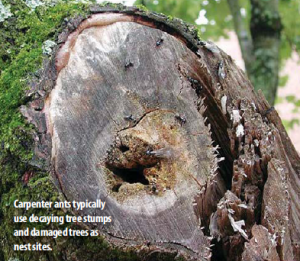The old joke was: “you can identify a carpenter ant by his tool belt.” But the carpenter ant is nothing to laugh at.
According to Dr. Laurel Hanson and John Klotz, in their 2005 book, “Carpenter Ants of the United States and Canada,” there are approximately 50 species of carpenter ants in North America. Of these 50, about 24 are considered to be structural or nuisance pests. A few of these, such as the Camponotus tortuganus and the Camponotus variegatus are found only in relatively small geographic areas.
Most of the representative species are spread over wider geographic areas. It has been called one of the most common and destructive pests in U.S. homes and businesses. The nesting behavior of the carpenter ants is interesting. The parental colony creates a mating flight or swarm in the spring. In some species, prior to the swarm, alates “sunbathe”
— the swarming ants gather around the outside of the nest entrance and sun themselves — before flying. A pheromone is released by one of the male ants, which is the signal for the colony to take flight and swarm.
The ants mate during this swarm, after which the male normally dies. The female, now inseminated, falls to the ground, removes her wings and looks for a suitable nest site. The nest sites are typically found under debris and loose tree bark, in soft decaying tree stump wood and damaged trees, or in landscape materials. The female creates a cell in the nest site where she will start the new colony. Once this cell is formed, the female lays several eggs. While tending to these first few eggs she obtains nutrition by absorbing the flight or wing muscles she no longer uses back into her body.
The first eggs hatch over a two- to five-week time period, depending on specie and the environmental conditions. The queen provides the new larvae with nutrition from her body by metabolizing body fats and other parts, which are no longer needed. Once the first brood of ants hatch and mature, they take over the duties of tending the eggs and gathering the food.
The second batch of eggs is created when the first brood reaches the pupae stage. In the ant colony’s first couple of
years, the numbers are relatively small. Again depending on the specie, it may take several years for the colony to mature, begin swarming and create expansion. Mature colonies of carpenter ants are normally split up into a parent colony or nest site, and one or more satellite nest sites. The parent site contains the queen, eggs, early instar larva and some workers.
The young larva and eggs require greateramounts of moisture so the parent colony site is often low to the ground and at, or very near, a moisture source. The satellite nest contains the swarmers, late instarlarva, pupae and workers. It is usually higher off the ground in dry warm places such as tree tops or indoors. The parent and satellite sites are often connected by a worn trail created by the workers as they move back and forth transporting food between the two locations. Finding these trails will help identify the locations of the nest sites, which often is critical for providing control.

Leave A Comment